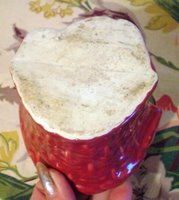Doug and I traveled to Jefferson City Saturday for an organic conference. We learned a ton about farming and about the state of organic farming in Missouri, and got to meet a lot of nice people. Although I don't farm, I have a deep interest in the organic industry as a whole, I buy much of my food organic (when the prices aren't unreasonably high), and I keep my yard organically. Several farmers gave talks about their business, clever solutions to different setbacks (many of the setbacks seem to come from being small, not from being organic), and the markets for their goods. One thing that struck me was how
practical most were (I LOVE being back in the Midwest!).
I heard multiple times that "profit is not a dirty word," and a couple of farmers even came right out and said they wouldn't farm organically if they couldn't make a profit. These guys didn't strike me as greedy, and they weren't wearing expensive clothes and jewelry, or driving expensive cars -- they are practical people that realize to make any business work, you have to make a profit or your money runs out and you have to do something else for a living. Many do not appear to put profit above all else (unlike so many large businesses), just high enough so they can keep doing what they love, and live the way they want to live.
The talk about profit encouraged me much more than any talk of idealism could have. While I repect the idealism involved with organics and even share some of it myself, idealism can not make crops grow, and it can not advance the science enough to make organic a standard, approachable way of doing things. Those of us who only have a yard to keep can be organic through benign neglect: not so for the farmer.
I especially appreciated listening to Keith from
Super Gro of Iowa, who broke down each section of a soil test and told us what each part meant. Many labs will tell you "add
nitrogen" or "add lime," but without a good understanding of the entire balance of nutrients in the soil those recommendations can be dead wrong. If you've been organic for awhile, it won't surprise you to find that the reading for nitrogen (the "N" in N-P-K) isn't all that important; newcomers would probably be confused to find that the speaker just blanked out the entire nitrogen section of the report. If everything
else is where it needs to be, there will be enough
available nitrogen to grow crops.
It surprised me a little to find out what kind of prices are being offered for organic crops: often several times more than for their non-organic counterparts. Although I'm used to seeing higher prices for organic food in grocery stores, it's nice to know that some of that gets back to the farmer. Expenses like storage and shipping take out a much larger percentage of the bottom line for a small farm. Unlike conventional agriculture, organic agriculture is still an industry where supply and demand determine the prices and production quantities. Right now, demand far outpaces supply. Those who can afford to pay a little more for organic are helping to keep the demand high; if everything works the way it should (meaning if the gov't lets the market work the way it should instead of letting special interests manipulate it like with conventional ag), supply will eventually catch up and we consumers will eventually enjoy lower prices.
Click here for more information about Missouri Organic Association.
 Marykay sent an email about the green dog planter on my unknown animal pottery page. She has the same planter in a dark red color -- which may provide another clue to its maker -- and was nice enough to send me some pictures.
Marykay sent an email about the green dog planter on my unknown animal pottery page. She has the same planter in a dark red color -- which may provide another clue to its maker -- and was nice enough to send me some pictures. If this is one of those three I would probably guess Morton, although it would only be a guess. The Shawnee red glaze is shinier and a bit more transparent, and the red is deeper. The Camark red is deeper yet (and is one of the prettiest colors I've seen). It's hard to tell exact color when viewing a digital picture, but the glaze does seem to have the same characteristics as some Morton flower pots I have packed away somewhere. Or it could have been made by an entirely different pottery, one for whom we haven't found an identification book for yet. The unglazed bottom also makes me less likely to think it's Shawnee or Camark.
If this is one of those three I would probably guess Morton, although it would only be a guess. The Shawnee red glaze is shinier and a bit more transparent, and the red is deeper. The Camark red is deeper yet (and is one of the prettiest colors I've seen). It's hard to tell exact color when viewing a digital picture, but the glaze does seem to have the same characteristics as some Morton flower pots I have packed away somewhere. Or it could have been made by an entirely different pottery, one for whom we haven't found an identification book for yet. The unglazed bottom also makes me less likely to think it's Shawnee or Camark.